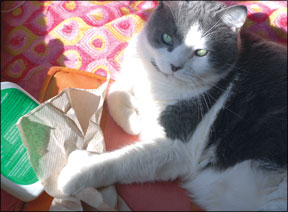The cleanser you scrubbed your counter with makes your kitchen smell fresh and clean. It also makes it into a hazardous waste site for your cat.
Common household cleaners carry labels warning of their dangers, and so most people use gloves or wash their hands after using them. But every time your cat walks across a newly cleaned counter or floor and then grooms itself, it ingests the cleaning product. Even if you rinse and dry the area, some residue can

Bev Caldwell
288
remain.
Cleansers such as Lysol contain phenols and alcohol, both of which are toxic to cats and can cause digestive upset and irritations in the mouth. Bleach, a popular cleaning product, will cause skin irritation; when combined with ammonia, it forms poisonous chlorine gas. Any product containing pine oils, such as Pine Sol, can cause liver damage.
Some vets say theyve never seen an example of cleanser-caused toxicity in cats. But we know from human studies that the effects of environmental toxins are not always obvious. Rather than risk skin irritation or liver failure, why not use natural cleansers that are safe for pets and humans? And theres no need to spend a fortune on fancy “green” products, either. Your kitchen cupboard probably has all the cleaning power youll need to keep your home sparkling.
White distilled vinegar is the champion of natural cleaning. Its high acid level kills bacteria, germs and mold, while remaining safe enough to eat. This makes it an ideal cleanser for any surface your cat will come into contact with. Use a half-and-half solution of vinegar and water for counter surfaces and straight vinegar for heavy cleaning; half a cup of vinegar in a gallon of warm water works well on non-wood floors.
Many pets manage to drink out of toilet bowls despite their owners best efforts, which means theyll be drinking cleanser as well. So instead of using harsh chemical cleaners, pour undiluted vinegar into the toilet bowl and let it sit for ten minutes. Not only will the vinegar kill germs, it will also dissolve unsightly mineral build-up and stains on the porcelain (especially if you leave it in the toilet bowl for a few hours or over night).
Baking soda is the other natural cleanser of choice. Because of its abrasive texture, it works well for areas that need scrubbing, like bath tubs and sinks. It also combines well with vinegar for cleaning with an extra punch.
Although natural cleaning products are not poisonous, they still need to be handled properly. For example, eating more than a few tablespoons of baking soda can cause digestive upset. Vinegar is an acid and can cause eye irritation. It can also discolor some fabrics, so test vinegar on a seam or hidden area of the cloth before using.
How to Clean the Litter Box
Bacteria convert the urea in urine into ammonia, which explains the strong smell rising from uncleaned litter boxes. Ammonia is alkaline, so highly acid vinegar works instantly to neutralize its odor. After youve removed the soiled litter from your cats litter box, pour undiluted vinegar on the inner surface to get rid of any odor lingering in the plastic.
If your cat objects to the strong smell of vinegar, try sprinkling baking soda under the litter instead.
To make cleaning the litter box easier, spray it with cooking oil before you add clean litter. This helps prevent soiled litter from clinging to the surface.
Natural Odor Control
Our sense of smell is triggered by tiny particles floating through the air. Cat hairs on surfaces such as couches and rugs shed these particles into the air, resulting in that familiar musty cat odor. Rather than trying to cover up the smell with potentially toxic scents and sprays, attack the problem at the source.
Brush your cat frequently to reduce the amount of hair it sheds. Dispose of the cat hairs in a covered receptacle or a bag, so they dont continue to leach molecules into the air. Vacuuming your floors and furniture often will also help control the odor.
Keep a towel by the door to dry your pets feet when it comes into the house. Restrict wet pets to an area of the house without carpets and upholstered furniture that readily absorb scent.
Urine Stains
Whenever possible, clean up any urine or cat spray immediately, while its still wet. Blot the excess fluid, then flush the spot with a solution of one part vinegar to two parts warm water. Blot up the excess fluid again.
Another popular cleaning solution is a combination of hydrogen peroxide and baking soda (as with vinegar, test first to make sure theres no discoloration of the surface). Mix two cups of three percent hydrogen peroxide with one teaspoon of dishwashing liquid and one tablespoon of baking soda, and work into the carpet or rub onto the dirty spot. Let it dry, then vacuum up the residue.
Cleaning becomes trickier when the urine has already dried. Bacteria will continue to convert any remaining organic compounds into ammonia. Not only does this smell bad, its also an invitation to your cat to urinate in the same spot again. Fortunately, black light on cat urine causes it to glow, so you can use it to identify the source of any remaining odor. The glow is most obvious if the room is very dark. Battery-operated black lights are available on-line and at most pet stores.
Sometimes the problem is that the urine has seeped into the wood, or has settled into air pockets in a carpet. This makes it almost impossible to clean thoroughly. In such cases, using an enzyme product that neutralizes the bacteria may eliminate the odor.
If your clothing has been stained with urine, pour some vinegar onto the stain and let it sit for a few minutes before laundering as usual. (Remember to test the vinegar to make sure it doesnt discolor the fabric.)
With a little ingenuity and a trip to your kitchen pantry, you can have a clean, safe house for you and your pets – the natural way.



